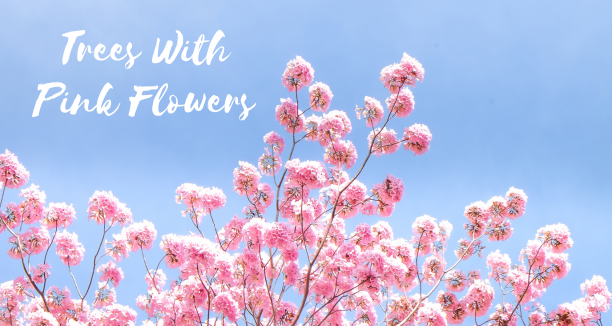Few things can rival vibrant pink blossoming trees’ breathtaking and extravagant beauty. These flowering trees serve as the ideal complement to your springtime floral display, including tulips and various flowering bulbs, and they come in a wide range of choices suitable for every garden type and size.
When selecting flowering trees for your garden, prioritize species well-suited to your USDA Hardiness Zone (you can determine your zone here). Additionally, ensure ample space for their growth by referring to the plant tag or description for their mature size. While a young tree in a gallon-sized pot may seem minor initially, thoughtful planning prevents future maintenance challenges a few years later.
- Begin by digging a hole that is approximately two to three times larger than the width of the container in which the tree was initially grown.
- When placing the tree in the hole, ensure it sits at the same depth as in the pot. If the tree was previously balled and burlapped, carefully remove the burlap, string, or wire (as the burlap does not biodegrade quickly enough for the tree’s roots to expand).
- Gently position the tree in the prepared hole, backfill it with soil, and tamp it down to eliminate air pockets.
- Water the newly planted tree thoroughly to ensure the soil settles around the roots.
- Maintain consistent watering throughout the first season to help establish a strong and healthy root system for your tree.
In the end, avoid placing compost or other amendments directly into the planting hole. This traditional practice is no longer advisable as it can lead to drainage problems. Instead, encourage your young tree to adapt and thrive in its natural soil.
Here are our top selections for the most beautiful pink-blossomed trees:
1. Redbud
This tree is among the earliest to bloom each spring, showcasing its vibrant hot pink flowers even before its leaves appear. It’s a perfectly compact choice for numerous garden spaces, as most varieties reach a manageable height of 15 to 25 feet.
2. Magnolia
A diverse array of magnolia varieties exists, making it possible to cultivate these beautiful trees throughout the United States. Southern magnolias stand as the traditional choice, thriving in warmer regions. However, you’ll also encounter saucers and star magnolias tailored for colder climates in different parts of the country. Be sure to carefully review their descriptions to select a magnolia that aligns with the environment of your location.
3. Weeping Cherry
Graceful, gracefully arched branches adorned with vibrant pink blossoms in the early to mid-spring season make this tree an essential addition to any garden. Numerous varieties also showcase stunning autumn foliage in orange, gold, or red shades.
4. Camellia
Camellias exhibit a timeless, vintage charm characterized by glossy green foliage and abundant, vibrant blossoms. Various cultivated strains of these broadleaf evergreens flourish from late autumn to the onset of spring, showcasing a spectrum of colors that spans from delicate pink to the richest crimson.
5. Weigela
This compact shrub, reaching a maximum size of four to five feet in height and width, is an ideal substitute when limited space and a mature tree are not feasible. It boasts stunning trumpet-shaped flowers that are highly attractive to pollinators, particularly hummingbirds. Additionally, specific varieties of this shrub exhibit the unique feature of reblooming consistently throughout the season.
6. Pink Dogwood
In mid to late spring, the timeless tree bursts into bloom, showcasing its sizable flowers that transform into vibrant red fruits, a favorite among birds. Most cultivars typically reach a mature height of 15 to 25 feet.
7. Crabapple
In the heart of spring, crabapple trees adorn their branches with abundant, vibrant pink blossoms, while select varieties boast rich burgundy foliage. These inviting trees become a haven for birds, who eagerly feast on their bountiful berries.
8. Crape Myrtle
Crape myrtle trees showcase many captivating flower varieties, with their most striking blooms appearing in delicate shades of pale pink, vibrant fuchsia, and deep red. These remarkable super-bloomers adorn the landscape with exquisite, frilly flowers throughout the summer. Additionally, certain crape myrtle varieties stay compact, reaching heights of only around 10 feet, making them an ideal choice for smaller gardens and landscapes.
9. Oakleaf Hydrangea
This expansive shrub attains a height of approximately 5 feet, making it a suitable choice when space constraints prevent tree planting. Its exquisite blossoms transition from white to a soft blush and ultimately to a deep red hue, and these delicate, papery blooms persist from mid-summer throughout the winter season, injecting vitality into your garden even as other elements fade. Remarkably, it is the sole variety of hydrangea that also graces your landscape with brilliant autumn foliage.
10. Rhododendron
This striking broadleaf evergreen boasts impressive, sizable blossoms during the middle of spring. Certain variations grow to substantial heights, offering an effective screen, privacy, and a burst of vibrant color.
11. Pink Japanese Snowbell
This lesser-known flowering tree showcases enchanting blush-pink, bell-shaped blossoms that adorn its branches from late spring to early summer. Its captivating weeping silhouette and sweet cotton-candy-scented flowers make it a true standout in any landscape!
12. Crimson Horse Chestnut
The Red Horse Chestnut (Aesculus × cornea) is a tall tree known for its striking pink flowers that can reach up to 40 feet when fully mature. Initially, the blossoms start red but gradually transform into a deep pink hue as they age. The “x” in its botanical name signifies that this tree is a hybrid resulting from a cross between the Red Buckeye (Aesculus pavia) and the Common Horse Chestnut (Aesculus hippocastanum). Its spiky flower clusters measure 6 to 8 inches in length and stand out against the backdrop of dark green foliage, adding to its ornamental appeal. The tree’s namesake nuts are shiny and approximately 1 inch wide. It’s important to note that these nuts are toxic and should not be confused with edible chestnuts, as horse chestnuts develop a fleshy, bumpy husk with a distinctive wart-covered appearance.
FAQS
What is the common name of the pink-blossomed tree?
The Eastern Redbud tree, indigenous to the eastern United States, enhances landscapes with its vibrant pink blossoms. These trees can be cultivated for various purposes, including ornamental shrub borders, within woodland settings, or as striking specimen trees.
Which trees blossom with pink flowers during the spring season?
The redbud tree, known for its vibrant hot pink blossoms that emerge in early spring, precedes its foliage. Its moderate size makes it suitable for a wide range of garden spaces, typically reaching 15 to 25 feet in most varieties.
Which tree bears pink edible flowers?
As legume family members, these trees yield numerous edible buds ranging from magenta to pale pink hues, offering a unique raw taste reminiscent of sugar snap pea pods.
What is the tree with pink blossoms that blooms during the autumn season?
The Pink Velour Crape Myrtle showcases its delicate, pure pink blossoms throughout the summer and fall. This vibrant pink-blooming tree boasts a compact stature, maturing to a height of only ten feet. If you desire a more enormous tree, consider the Tuscarora Crape Myrtle as an alternative option.
Which tree resembles a cherry blossom tree?
Crabapples (Malus species) and pears (Pyrus species) bloom concurrently with certain cherry species and share strikingly similar blossoms. (All belong to the Rosaceae family, commonly known as the rose family.) A distinguishing characteristic is their bark: crabapples and pears exhibit light-hued bark adorned with vertical fissures.
What is a pink-flowering money tree?
Crassula ovate, often called the jade plant, lucky plant, money plant, or money tree, is a succulent native to the KwaZulu-Natal and Eastern Cape regions of South Africa and Mozambique. Characterized by its vibrant green leaves and occasional small pink or white flowers, this plant has become a common houseplant worldwide.
For more articles, click here.



